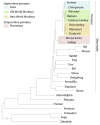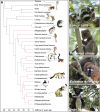The Mouse Lemur, a Genetic Model Organism for Primate Biology, Behavior, and Health
- PMID: 28592502
- PMCID: PMC5499178
- DOI: 10.1534/genetics.116.199448
The Mouse Lemur, a Genetic Model Organism for Primate Biology, Behavior, and Health
Abstract
Systematic genetic studies of a handful of diverse organisms over the past 50 years have transformed our understanding of biology. However, many aspects of primate biology, behavior, and disease are absent or poorly modeled in any of the current genetic model organisms including mice. We surveyed the animal kingdom to find other animals with advantages similar to mice that might better exemplify primate biology, and identified mouse lemurs (Microcebus spp.) as the outstanding candidate. Mouse lemurs are prosimian primates, roughly half the genetic distance between mice and humans. They are the smallest, fastest developing, and among the most prolific and abundant primates in the world, distributed throughout the island of Madagascar, many in separate breeding populations due to habitat destruction. Their physiology, behavior, and phylogeny have been studied for decades in laboratory colonies in Europe and in field studies in Malagasy rainforests, and a high quality reference genome sequence has recently been completed. To initiate a classical genetic approach, we developed a deep phenotyping protocol and have screened hundreds of laboratory and wild mouse lemurs for interesting phenotypes and begun mapping the underlying mutations, in collaboration with leading mouse lemur biologists. We also seek to establish a mouse lemur gene "knockout" library by sequencing the genomes of thousands of mouse lemurs to identify null alleles in most genes from the large pool of natural genetic variants. As part of this effort, we have begun a citizen science project in which students across Madagascar explore the remarkable biology around their schools, including longitudinal studies of the local mouse lemurs. We hope this work spawns a new model organism and cultivates a deep genetic understanding of primate biology and health. We also hope it establishes a new and ethical method of genetics that bridges biological, behavioral, medical, and conservation disciplines, while providing an example of how hands-on science education can help transform developing countries.
Keywords: Madagascar; Microcebus; model organism; mouse lemur; primate genetics.
Copyright © 2017 by the Genetics Society of America.
Figures






References
-
- Abbott A., 2010. Mouse project to find each gene’s role. Nature 465: 410. - PubMed
-
- Ali J. R., Huber M., 2010. Mammalian biodiversity on Madagascar controlled by ocean currents. Nature 463: 653–656. - PubMed
-
- Alleaume C., Mrini M. E., Laloy E., Marchal J., Aujard F., et al. , 2017. Scleral and corneal xanthomatous inflammation in a gray mouse lemur (Microcebus murinus). Vet. Ophthalmol. 20: 177–180. - PubMed
-
- Andrade M. C., Ribeiro C. T., Silva V. F., Molinaro E. M., Goncalves M. A., et al. , 2004. Biologic data of Macaca mulatta, Macaca fascicularis, and Saimiri sciureus used for research at the Fiocruz primate center. Mem. Inst. Oswaldo Cruz 99: 581–589. - PubMed
-
- Andres M., Solignac M., Perret M., 2003. Mating system in mouse lemurs: theories and facts, using analysis of paternity. Folia Primatol. (Basel) 74: 355–366. - PubMed
Publication types
MeSH terms
Grants and funding
LinkOut - more resources
Full Text Sources
Other Literature Sources
Research Materials
Miscellaneous

